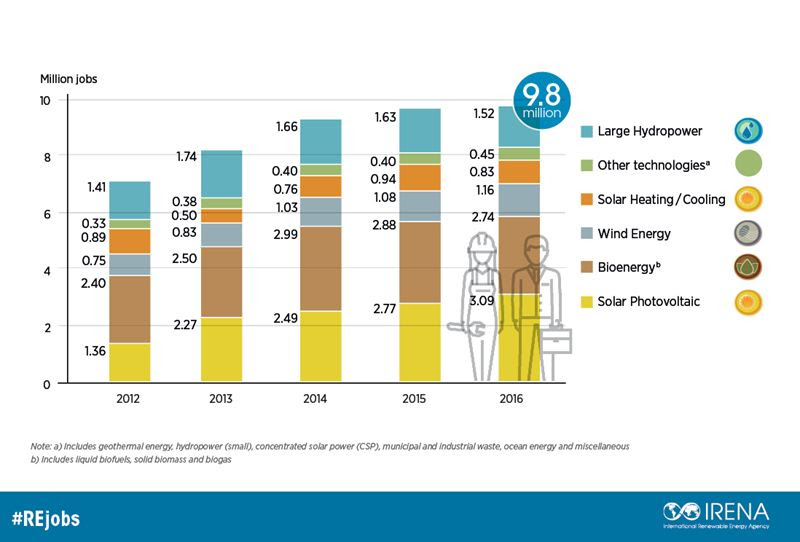Global energy system creating more jobs in renewables than in fossil-fuel technologies, according to IRENA Annual Review 2017
More than 9.8 million people were employed in the renewable energy sector in 2016 — continuing to increase over 2015 numbers — according to a new report from the International Renewable Energy Agency (IRENA). Released at the organization’s recent council meeting, the fourth edition Renewable Energy and Jobs –(IRENA) Annual Review 2017 provides the latest employment figures in the renewable energy (RE) sector, as well as insight into factors affecting the RE labor market. The report presents the status of renewable energy employment, both by technology and in selected countries, over the past year.
 “Falling costs and enabling policies have steadily driven up investment and employment in renewable energy worldwide since IRENA’s first annual assessment in 2012,” says IRENA Director-General Adnan Z. Amin, “when just over five million people were working in the sector. In the last four years, for instance, the number of jobs in the solar and wind sectors combined has more than doubled. Renewables are directly supporting broader socio-economic objectives, with employment creation increasingly recognized as a central component of the global energy transition. As the scales continue to tip in favor of renewables, we expect that the number of people working in the renewables sector could reach 24 million by 2030, more than offsetting fossil-fuel job losses and becoming a major economic driver around the world.”
“Falling costs and enabling policies have steadily driven up investment and employment in renewable energy worldwide since IRENA’s first annual assessment in 2012,” says IRENA Director-General Adnan Z. Amin, “when just over five million people were working in the sector. In the last four years, for instance, the number of jobs in the solar and wind sectors combined has more than doubled. Renewables are directly supporting broader socio-economic objectives, with employment creation increasingly recognized as a central component of the global energy transition. As the scales continue to tip in favor of renewables, we expect that the number of people working in the renewables sector could reach 24 million by 2030, more than offsetting fossil-fuel job losses and becoming a major economic driver around the world.”
The annual review demonstrates that global renewable-energy employment reached 8.3 million in 2016 without factoring in large hydropower. When accounting for direct employment in large hydropower, the total number of renewable-energy jobs globally climbs to 9.8 million. China, Brazil, the United States, India, Japan, and Germany account for most RE jobs. In China alone, 3.64 million people worked in renewables in 2016, a rise of 3.4%. The report finds that globally, 62% of the jobs are in Asia. Installation and manufacturing jobs continue to shift to the region, particularly to Malaysia and Thailand, the global center for solar PV fabrication. In Africa, utility-scale renewable energy developments have made great strides, with South Africa and North Africa accounting for 75% of the continent’s 62,000 renewable jobs.
Solar and wind employment soared in 2016
IRENA’s report shows that solar photovoltaic (PV) was the largest employer in 2016, with 3.1 million jobs globally — up 12% from the previous year — mainly in China, the United States, and India. Jobs in the U.S. solar industry increased 17 times faster than the overall economy, growing 24.5% from 2015 to over 260,000. New wind installations raised global wind employment, up to 1.2 million jobs, a 7% increase. Brazil, China, the United States and India also proved to be key bioenergy job markets, with biofuels accounting for 1.7 million jobs, biomass 0.7 million, and biogas 0.3 million.
“IRENA has provided this year a more complete picture on the state of employment in the renewables sector by including large hydropower data,” says Dr. Rabia Ferroukhi, Head of IRENA’s Policy Unit and Deputy Director of Knowledge, Policy, and Finance. “It is important to recognize these additional 1.5 million working people, as they represent the largest renewable energy technology by installed capacity.” In some African countries, with the right resources and infrastructure, we are seeing jobs emerge in manufacturing and installation for utility-scale projects. For much of the continent, however, distributed renewables, like off-grid solar, are bringing energy access and economic development. These microgrid solutions are giving communities the chance to leap-frog traditional electricity infrastructure development and create new jobs in the process.”
